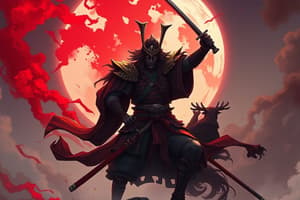Podcast
Questions and Answers
Who is considered the highest in society in Feudal Japan?
Who is considered the highest in society in Feudal Japan?
- Emperor (correct)
- Samurai
- Shogun
- Daimyo
What was the original role of the Shogun before Minamoto Yoritomo?
What was the original role of the Shogun before Minamoto Yoritomo?
Military leaders with the right to wage wars.
The title of Shogun became hereditary after Minamoto Yoritomo's changes.
The title of Shogun became hereditary after Minamoto Yoritomo's changes.
True (A)
What was the main function of the Peasants for the Shoguns?
What was the main function of the Peasants for the Shoguns?
The word 'Samurai' means to ______.
The word 'Samurai' means to ______.
Artisans were organized into guilds and had strict apprenticeship requirements.
Artisans were organized into guilds and had strict apprenticeship requirements.
Who were expected to lie flat on the ground as a sign of respect when a Daimyo passed?
Who were expected to lie flat on the ground as a sign of respect when a Daimyo passed?
Which class was considered the lowest in society in Feudal Japan?
Which class was considered the lowest in society in Feudal Japan?
Flashcards are hidden until you start studying
Study Notes
Feudal Japan Social Structure
-
Emperor
- Highest rank in society but limited power compared to the Shogun.
-
Shogun
- Originally a title for military leaders with authority to wage wars.
- Minamoto Yoritomo forced the imperial court to grant him the title after the Emperor's death.
- Changed the title from military command to hereditary governance over Japan.
-
Daimyo
- Most privileged class, acting as regional warlords representing the Shogun.
- Faced restrictions imposed by Tokugawa to limit their power.
- Expected to show respect, with lower social ranks lying flat when a Daimyo passed by.
-
Samurai
- Term means "to serve"; status inherited from their parents.
- The only class besides Daimyo permitted to carry two swords.
- Had the authority to kill individuals of lower classes if disrespected.
-
Peasants
- Typically owned minimal land sufficient for self-sustenance.
- Provided tax revenue primarily in rice for the Shoguns.
- Harsh working conditions led many to leave for labor or servant roles in cities.
-
Artisans
- Included various male roles (masons, plasterers, cooks, swordsmiths) and female roles (weavers, fan-makers).
- Worked for Daimyo or the Bakufu and organized into guilds.
- Involved in strict apprenticeship systems for skill development.
-
Merchants
- Positioned as the lowest social class, perceived as benefitting from the labor of others.
- Education was prioritized, with training in reading, writing, and mathematics.
- Notably, many women in this class attained higher education levels than their counterparts in other classes.
Studying That Suits You
Use AI to generate personalized quizzes and flashcards to suit your learning preferences.




